
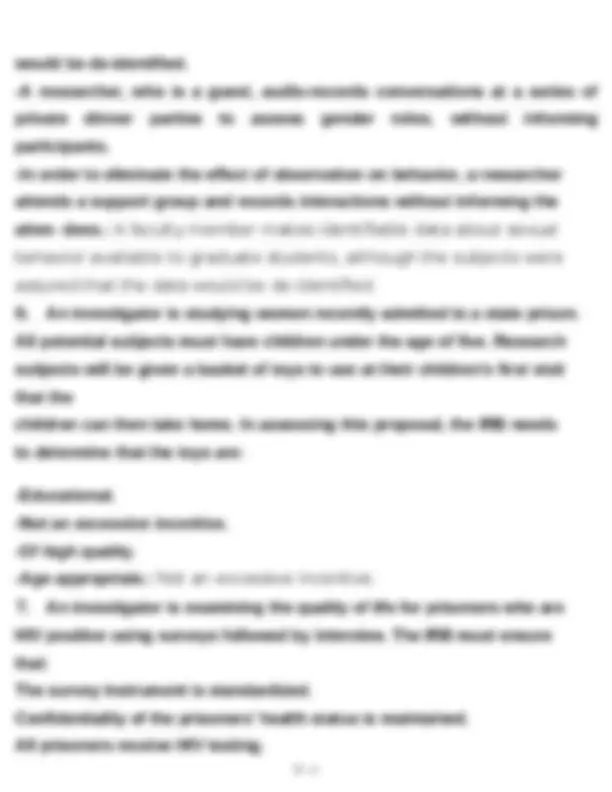
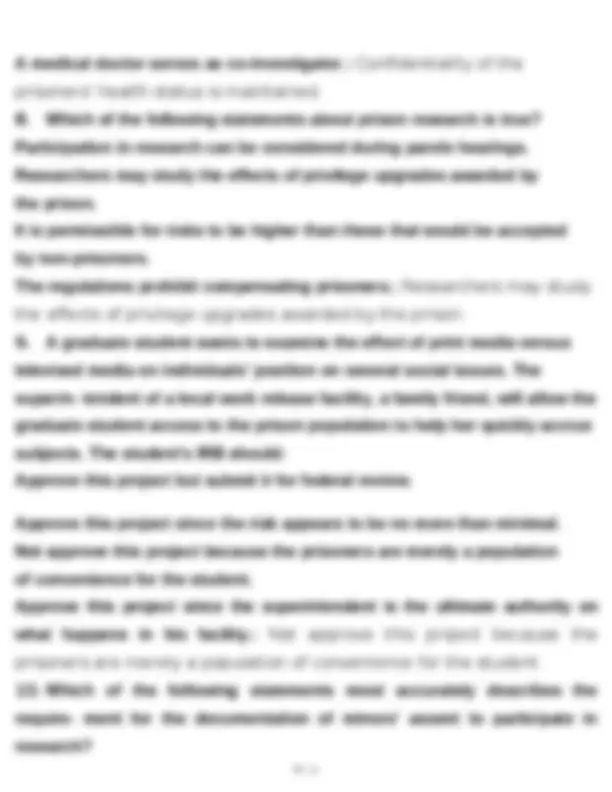
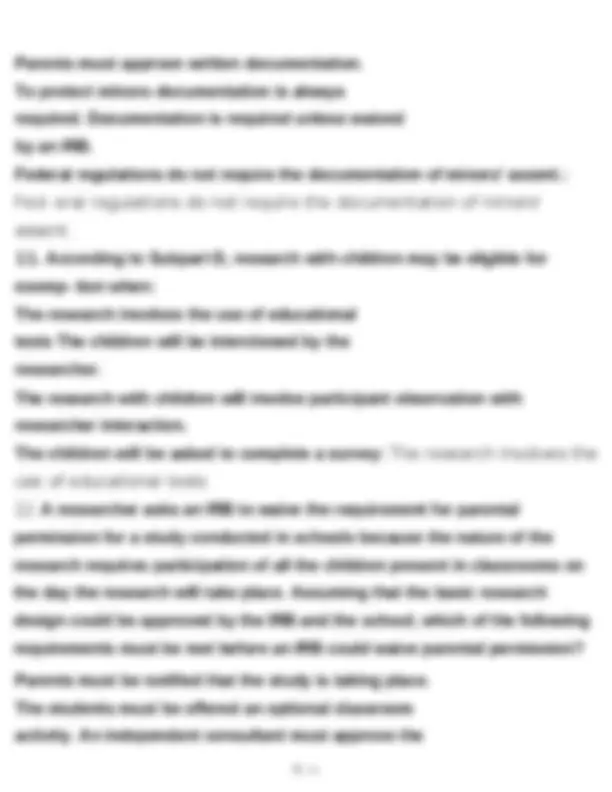
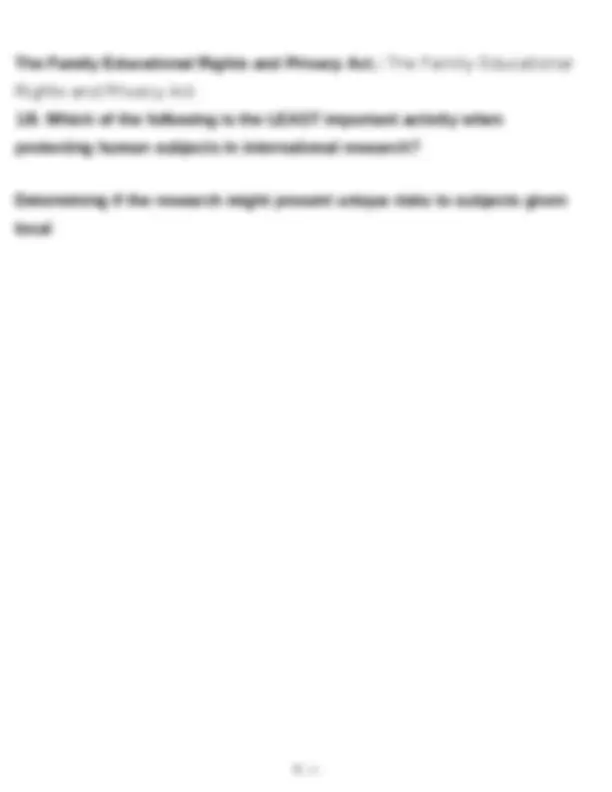
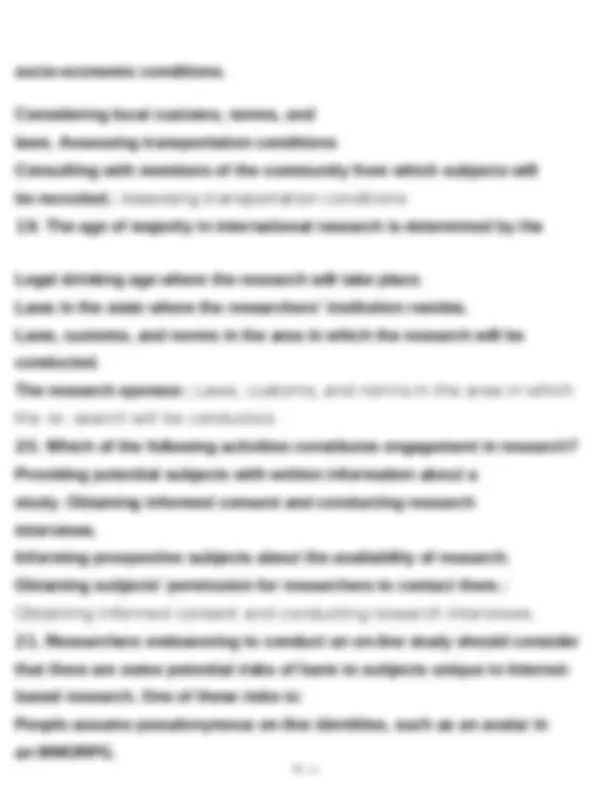
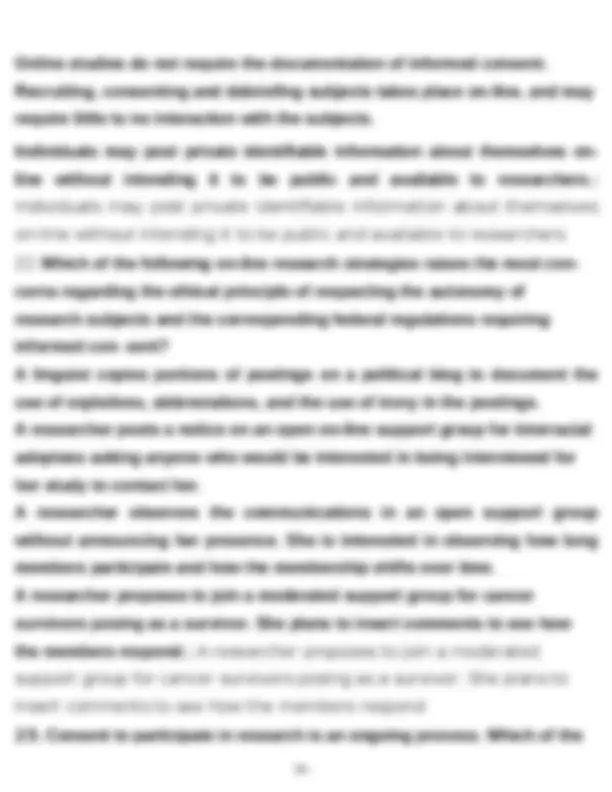
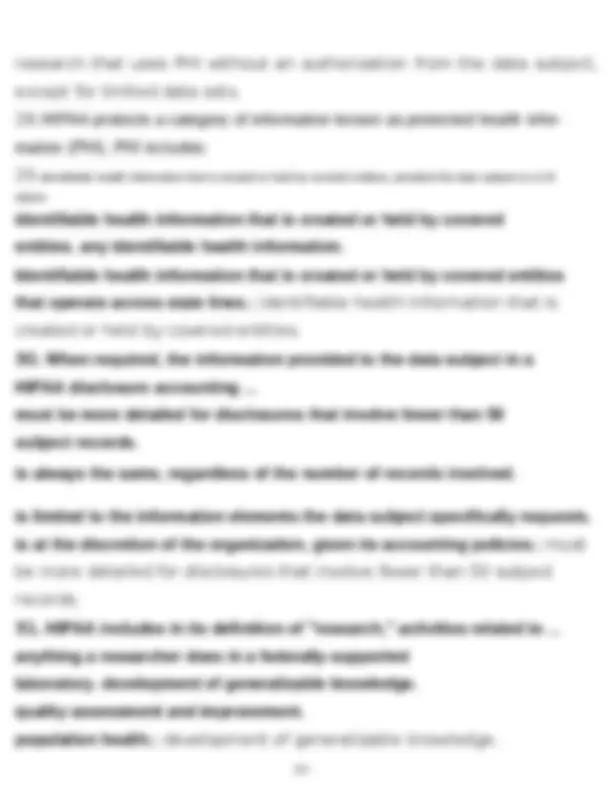
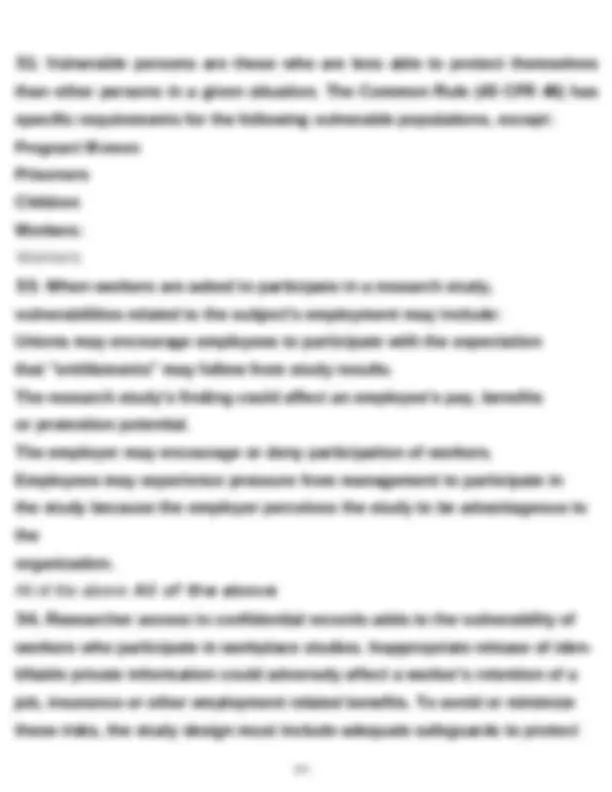
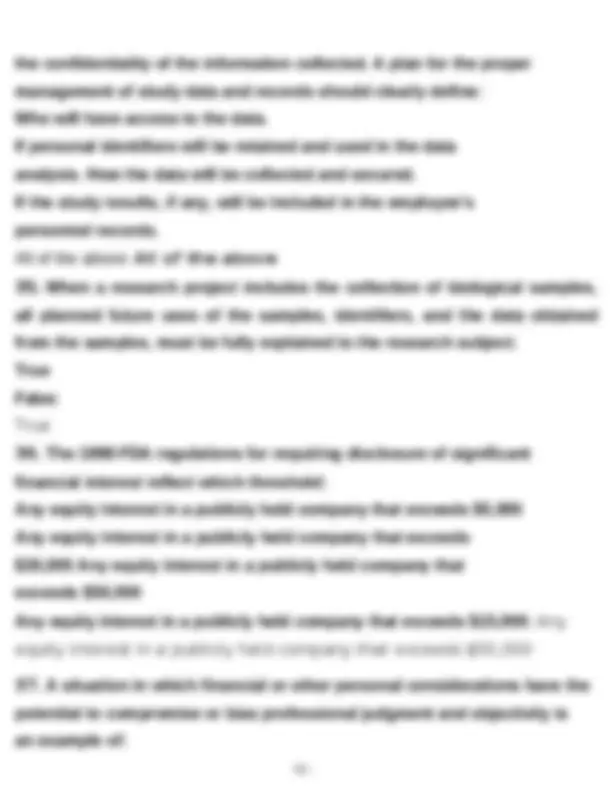
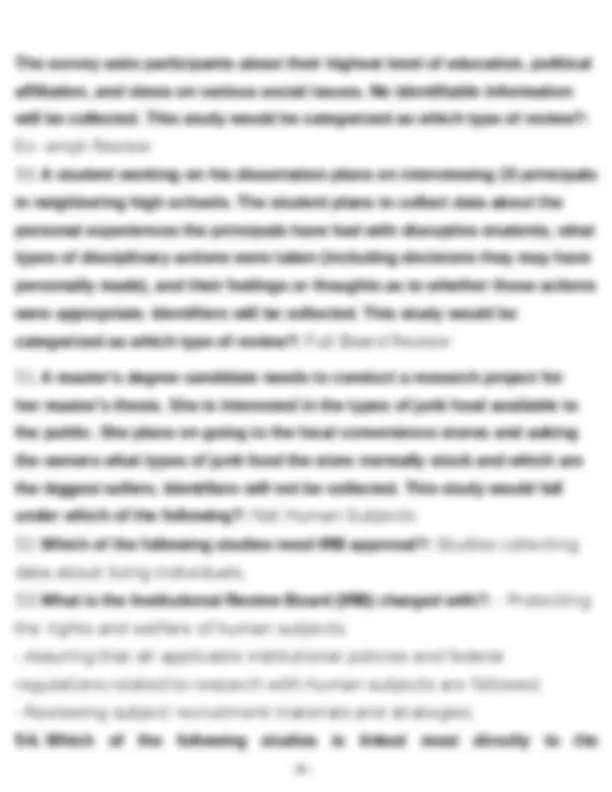
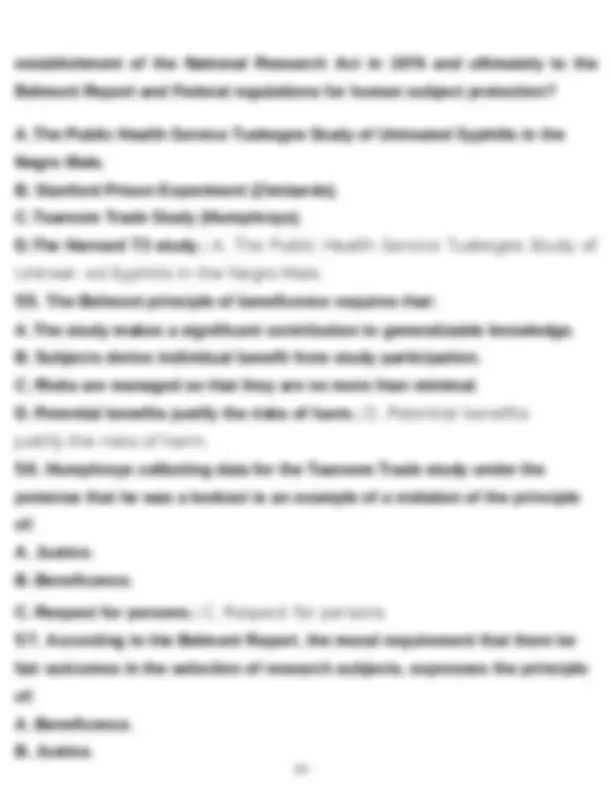
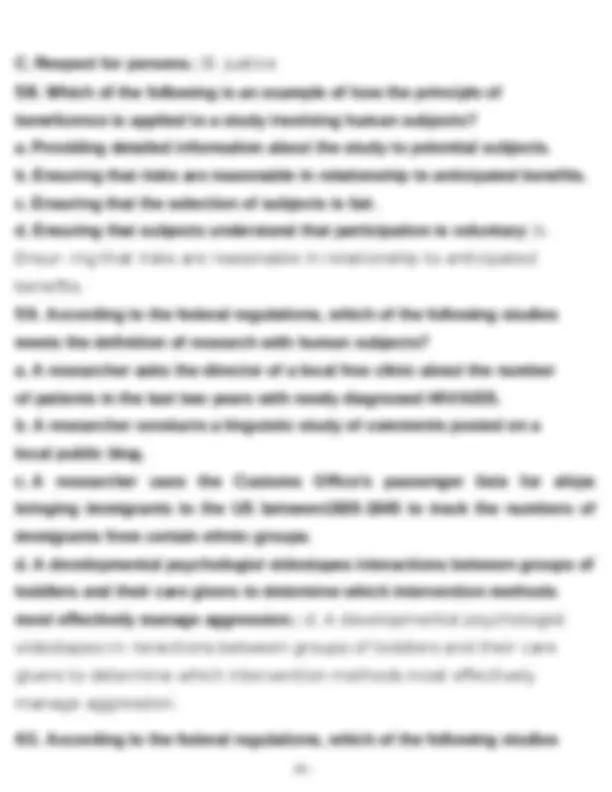
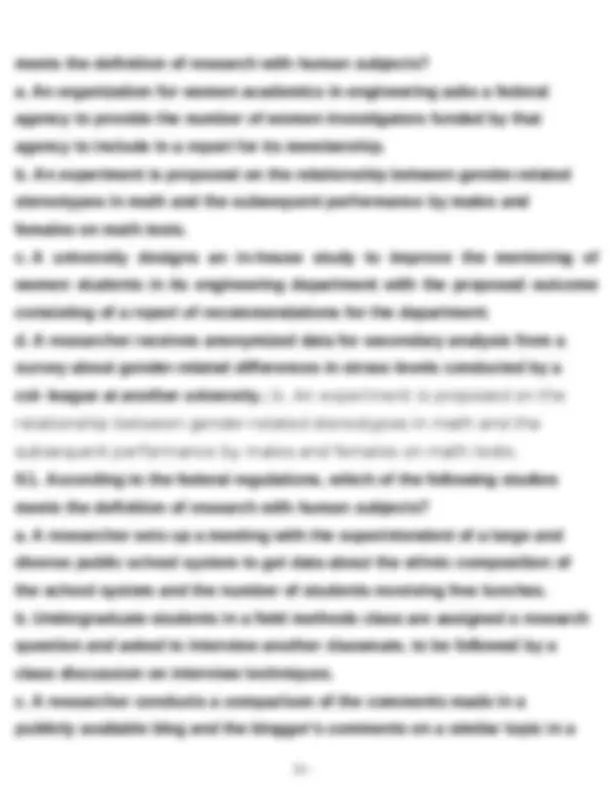
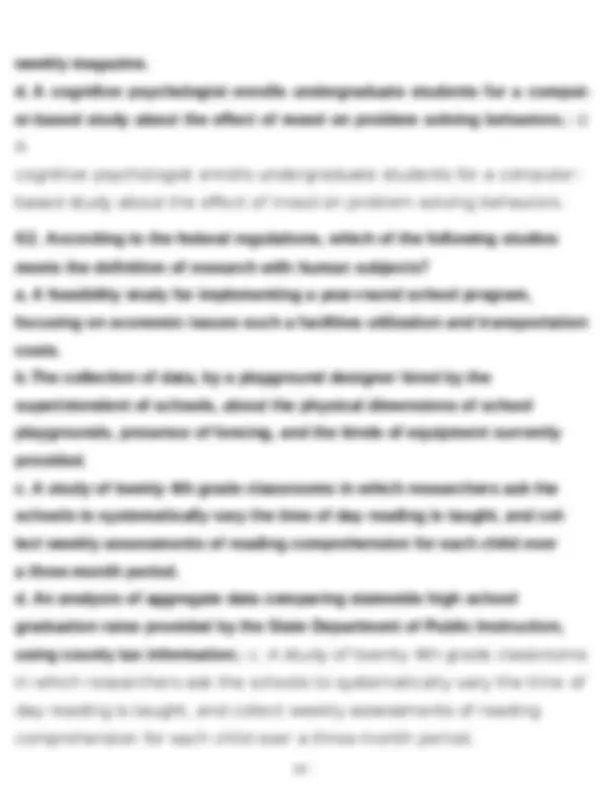
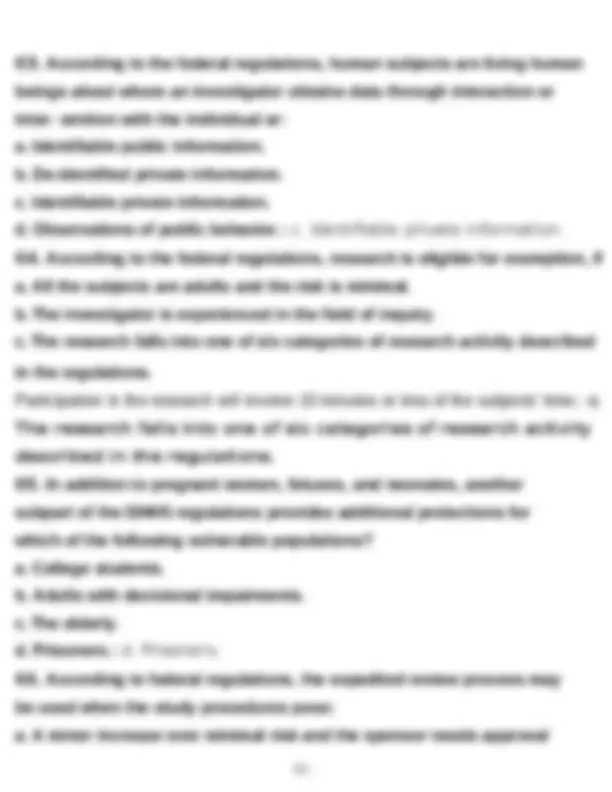
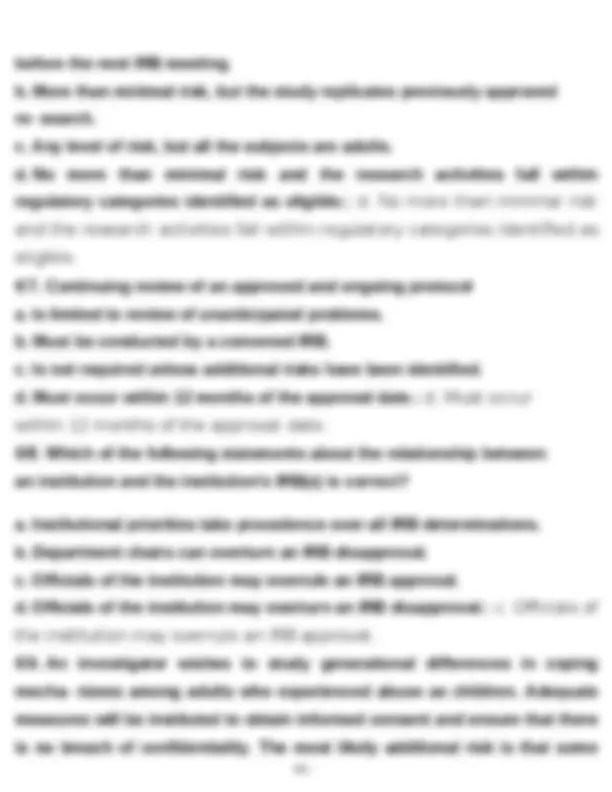
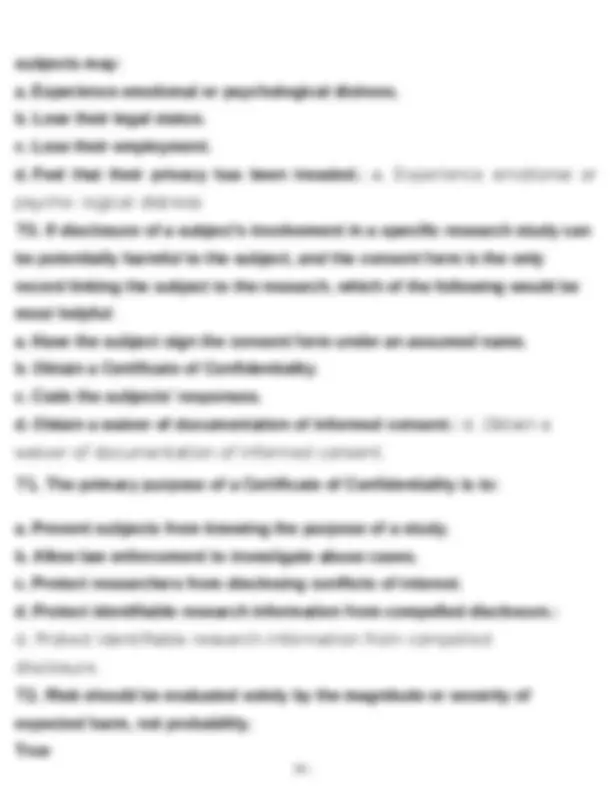
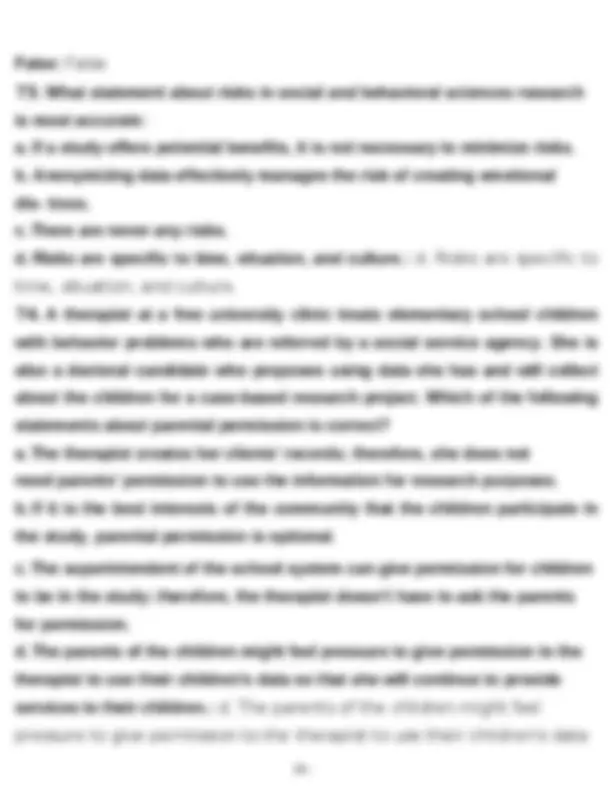
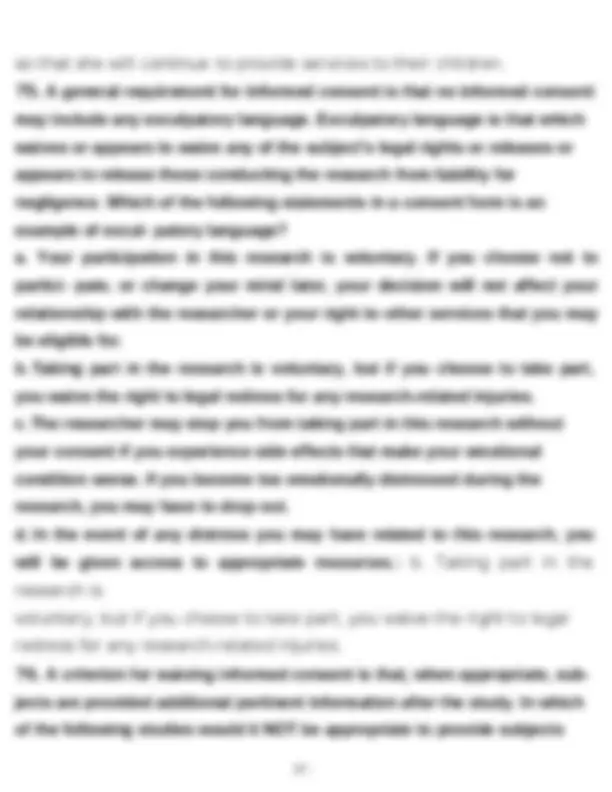
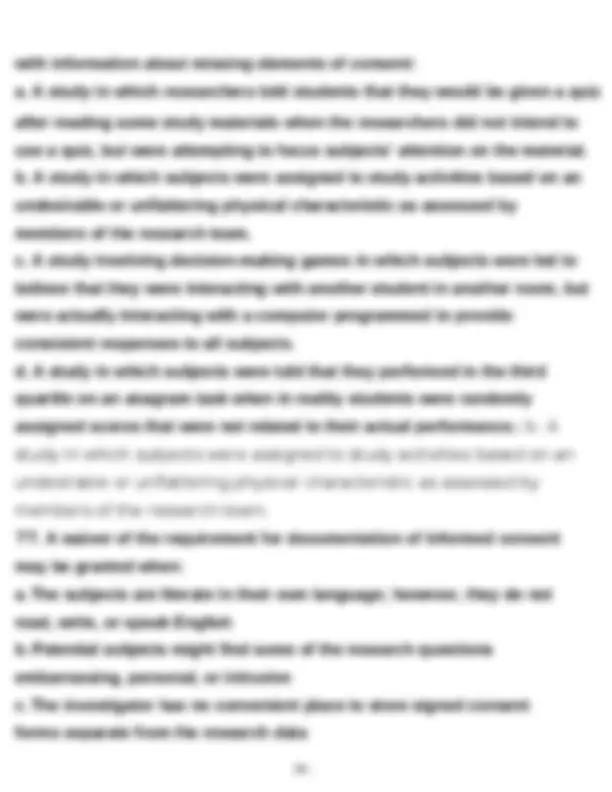
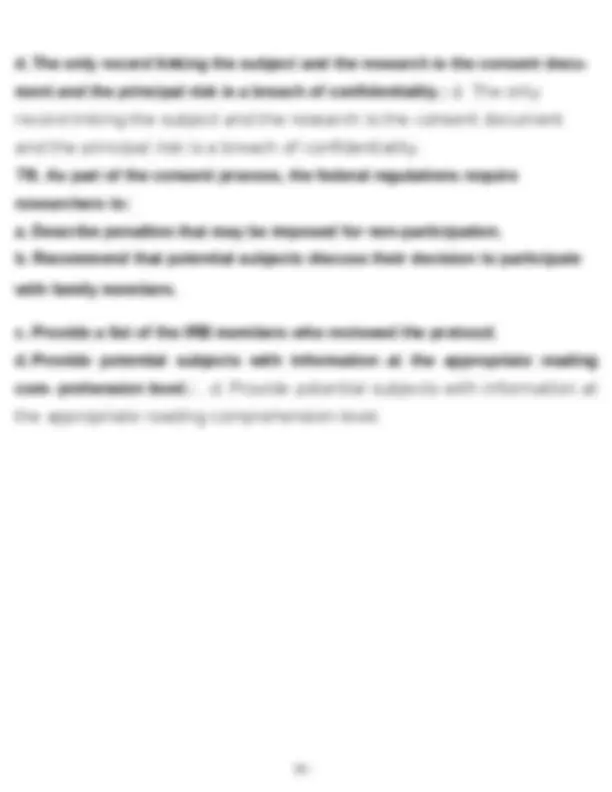


Study with the several resources on Docsity

Earn points by helping other students or get them with a premium plan


Prepare for your exams
Study with the several resources on Docsity

Earn points to download
Earn points by helping other students or get them with a premium plan
Community
Ask the community for help and clear up your study doubts
Discover the best universities in your country according to Docsity users
Free resources
Download our free guides on studying techniques, anxiety management strategies, and thesis advice from Docsity tutors
Various ethical considerations and procedures related to conducting research with human subjects. It covers topics such as confidentiality, privacy, informed consent, and the role of institutional review boards (irbs) in overseeing research. Scenarios involving research with children, prisoners, and employees, as well as online research methods. It also discusses the principles of the belmont report, including respect for persons, beneficence, and justice, and how they apply to human subjects research. Insights into the history and regulations governing ethical research practices, aiming to ensure the protection of research participants' rights and welfare.
Typology: Exercises
1 / 29

This page cannot be seen from the preview
Don't miss anything!






















CITI Module #
1. Data are made anonymous by -Destroying all identifiers connected to the data. -Requiring all members of the research team to sign confidentiality agree- ments. -Keeping the key linking names to responses in a secure location. -Reporting data in aggregate form in publications resulting from the research.- : Destroying all identifiers connected to the data. 2. In a longitudinal study that will follow children from kindergarten through high school and will collect information about illegal activities, which of the following confidentiality procedures would protect against compelled disclo- sure of individually identifiable information? -Using data encryption for stored files. -Securing a Certificate of Confidentiality. -Waiving documentation of consent. -Using pseudonyms in research reports.: Securing a Certificate of Confidentiality 3. When a focus group deals with a potentially sensitive topic, which of the fol- lowing statements about providing confidentiality to focus group participants is correct? -If group members know each other confidentiality is not an issue. -Using pseudonyms in reports removes the concern about any confidences shared in the group.
-The researcher cannot control what participants repeat about others outside the group. -If group participants sign confidentiality agreements, the researcher can guarantee confidentiality.: The researcher cannot control what participants repeat about others outside the group
4. A researcher leaves a research file in her car while she attends a concert and her car is stolen. The file contains charts of aggregated numerical data from a research study with human subjects, but no other documents. The consent form said that no identifying information would be retained, and the researcher adhered to that component. Which of the following statements best characterizes what occurred? -There was neither a violation of privacy nor a breach of confidentiality -The subjects' privacy has been violated. -Confidentiality of the data has been breached -There was both a violation of privacy and a breach of confidentiality.: There was neither a violation of privacy nor a breach of confidentiality 5. Which of the following constitutes both a breach of a confidentiality (the research data have been disclosed, counter to the agreement between re- searcher and subjects) and a violation of subjects' privacy (the right of the individuals to be protected against intrusion into their personal lives or af- fairs)? -A researcher asks cocaine users to provide names and contact information of other cocaine users who might qualify for a study. -A faculty member makes identifiable data about sexual behavior available to graduate students, although the subjects were assured that the data
A medical doctor serves as co-investigator.: Confidentiality of the prisoners' health status is maintained.
8. Which of the following statements about prison research is true? Participation in research can be considered during parole hearings. Researchers may study the effects of privilege upgrades awarded by the prison. It is permissible for risks to be higher than those that would be accepted by non-prisoners. The regulations prohibit compensating prisoners.: Researchers may study the effects of privilege upgrades awarded by the prison. 9. A graduate student wants to examine the effect of print media versus televised media on individuals' position on several social issues. The superin- tendent of a local work release facility, a family friend, will allow the graduate student access to the prison population to help her quickly accrue subjects. The student's IRB should: Approve this project but submit it for federal review. Approve this project since the risk appears to be no more than minimal. Not approve this project because the prisoners are merely a population of convenience for the student. Approve this project since the superintendent is the ultimate authority on what happens in his facility.: Not approve this project because the prisoners are merely a population of convenience for the student 10. Which of the following statements most accurately describes the require- ment for the documentation of minors' assent to participate in research?
Parents must approve written documentation. To protect minors documentation is always required. Documentation is required unless waived by an IRB. Federal regulations do not require the documentation of minors' assent.: Fed- eral regulations do not require the documentation of minors' assent.
11. According to Subpart D, research with children may be eligible for exemp- tion when: The research involves the use of educational tests The children will be interviewed by the researcher. The research with children will involve participant observation with researcher interaction. The children will be asked to complete a survey: The research involves the use of educational tests 12.A researcher asks an IRB to waive the requirement for parental permission for a study conducted in schools because the nature of the research requires participation of all the children present in classrooms on the day the research will take place. Assuming that the basic research design could be approved by the IRB and the school, which of the following requirements must be met before an IRB could waive parental permission? Parents must be notified that the study is taking place. The students must be offered an optional classroom activity. An independent consultant must approve the
institution. The superintendent of schools and the principals have approved the study.: - An IRB has approved a waiver of the requirement for parental permission
15. According to Subpart D, which of the following research activities with children would qualify for an exemption? Survey procedures Observation of public behavior when the researcher participates in the activ- ities being observed. Interviews Research about educational testing: Research about educational testing 16. The purpose of the Family Educational Rights and Privacy Act (FERPA) is to: Ensure that surveys do not ask school children to provide sensitive informa- tion about their parents. Provide parents certain rights over their children's educational records. Give school principals the right to discuss students' behavioral problems with their parents. Allow school counselors to access students' grades.: Provide parents certain rights over their children's educational records. 17. Which federal regulation or law governs how researchers can obtain data about subjects' disciplinary status in school from academic records? The No Child Left Behind Act. Subpart D of 45 CFR 46. The Protection of Pupil Rights Amendment.
The Family Educational Rights and Privacy Act.: The Family Educational Rights and Privacy Act
18. Which of the following is the LEAST important activity when protecting human subjects in international research? Determining if the research might present unique risks to subjects given local
Online studies do not require the documentation of informed consent. Recruiting, consenting and debriefing subjects takes place on-line, and may require little to no interaction with the subjects. Individuals may post private identifiable information about themselves on- line without intending it to be public and available to researchers.: Individuals may post private identifiable information about themselves on-line without intending it to be public and available to researchers. 22.Which of the following on-line research strategies raises the most con- cerns regarding the ethical principle of respecting the autonomy of research subjects and the corresponding federal regulations requiring informed con- sent? A linguist copies portions of postings on a political blog to document the use of expletives, abbreviations, and the use of irony in the postings. A researcher posts a notice on an open on-line support group for interracial adoptees asking anyone who would be interested in being interviewed for her study to contact her. A researcher observes the communications in an open support group without announcing her presence. She is interested in observing how long members participate and how the membership shifts over time. A researcher proposes to join a moderated support group for cancer survivors posing as a survivor. She plans to insert comments to see how the members respond.: A researcher proposes to join a moderated support group for cancer survivors posing as a survivor. She plans to insert comments to see how the members respond
23. Consent to participate in research is an ongoing process. Which of the
following strategies would help ensure that participation in a survey about a sensitive personal topic remains voluntary throughout a study? Designing the survey so that subjects are not forced to answer one question before going to the next. Giving examples in the consent process of the kinds of questions that will be asked. Including the institution's privacy policy on the survey site. Providing a thorough debriefing at the end of the study.: Designing the survey so that subjects are not forced to answer one question before going to the next
24. To minimize potential risks of harm, a researcher conducting an on- line survey can: Specify that all respondents must be legal adults. Suggest that subjects print a copy of the informed consent form for their records. Comply with the survey software's Terms of Service agreement. Design the survey so that no direct or indirect identifiers are collected.: Design the survey so that no direct or indirect identifiers are collected. 25.Which of the following examples of using the Internet to conduct research meets the federal definition of research with human subjects? Downloading a publically available dataset that includes high school students' academic achievement rates. The data are in aggregate and were derived from multiple school districts from different states. Gathering data to supplement an oral history project about a local civil rights activist. The activist passed away while the researcher was in the process of
research that uses PHI without an authorization from the data subject, except for limited data sets. 28.HIPAA protects a category of information known as protected health infor- mation (PHI). PHI includes: 29.identifiable health information that is created or held by covered entities, provided the data subject is a US citizen. identifiable health information that is created or held by covered entities. any identifiable health information. Identifiable health information that is created or held by covered entities that operate across state lines.: identifiable health information that is created or held by covered entities.
30. When required, the information provided to the data subject in a HIPAA disclosure accounting ... must be more detailed for disclosures that involve fewer than 50 subject records. is always the same, regardless of the number of records involved. is limited to the information elements the data subject specifically requests. is at the discretion of the organization, given its accounting policies.: must be more detailed for disclosures that involve fewer than 50 subject records. 31. HIPAA includes in its definition of "research," activities related to ... anything a researcher does in a federally-supported laboratory. development of generalizable knowledge. quality assessment and improvement. population health.: development of generalizable knowledge.
32. Vulnerable persons are those who are less able to protect themselves than other persons in a given situation. The Common Rule (45 CFR 46) has specific requirements for the following vulnerable populations, except: Pregnant Women Prisoners Children Workers: Workers 33. When workers are asked to participate in a research study, vulnerabilities related to the subject's employment may include: Unions may encourage employees to participate with the expectation that "entitlements" may follow from study results. The research study's finding could affect an employee's pay, benefits or promotion potential. The employer may encourage or deny participation of workers. Employees may experience pressure from management to participate in the study because the employer perceives the study to be advantageous to the organization. All of the above: All of the above 34. Researcher access to confidential records adds to the vulnerability of workers who participate in workplace studies. Inappropriate release of iden- tifiable private information could adversely affect a worker's retention of a job, insurance or other employment related benefits. To avoid or minimize these risks, the study design must include adequate safeguards to protect
Conflict of Interest Fraud Research Misconduct Malfeasance: Conflict of Interest
38. According to the DHHS 2011 updated of the PHS federal regulations, the threshold amount for reporting a significant financial interest (investigator and his/her spouse and dependents) is: Greater than $5,000 of ownership in any single public entity/company. $25,000 and 5% of ownership in any single entity/company. Greater than $2,000 or 2% of ownership in any single entity/company. Greater than $10,000 or 5% of ownership in any single entity/company.:
Greater than $5,000 of ownership in any single public entity/company. 39. The most important ethical concerns related to conflicts of interest in research are: Maintaining a supply of volunteers for research studies and their active in- volvement in research Ensuring the objectivity of research and the protection of human subjects Protecting proprietary information and fidelity to contracts with sponsors Establishing open dialog with sponsors and security of study records: Ensur- ing the objectivity of research and the protection of human subjects 40. A conflict of interest implies: The elimination of bias. The actual involvement of
bias. An awareness of bias. The potential for bias.: The potential for bias. 41.What are the 3 principles discussed in the Belmont Report?: Respect for Persons Beneficenc e Justice 42.What is an example of how the Principle of Beneficence can be applied to a study employing human subjects?: Determining that the study has a maximiza- tion of benefits and a minimization of risks. 43.All of the following are true regarding the Belmont Report, EXCEPT:: The Belmont Report indicates that it is necessary to rigorously avoid conflicts of interest. 44.The history of ethical regulations in human subjects research began with the: Nuremberg Code 45.Where could student researchers and/or student subjects find additional resources regarding the IRB approval process?: Faculty Advisor/Research Men- tor IRB Office 46.Which of the following elements must be included in an informed con- sent?: All foreseeable risks and discomforts. 47.Which type of IRB review does not require an IRB approval but does require a determination by the IRB or an IRB designee?: Exempt 48.How can faculty researchers avoid coercion of student subjects?: Avoid using their own students in their research 49.A student is conducting a research project that involves using a survey.
establishment of the National Research Act in 1974 and ultimately to the Belmont Report and Federal regulations for human subject protection? A. The Public Health Service Tuskegee Study of Untreated Syphilis in the Negro Male. B. Stanford Prison Experiment (Zimbardo). C. Tearoom Trade Study (Humphreys). D.The Harvard T3 study.: A. The Public Health Service Tuskegee Study of Untreat- ed Syphilis in the Negro Male.
55. The Belmont principle of beneficence requires that: A. The study makes a significant contribution to generalizable knowledge. B. Subjects derive individual benefit from study participation. C. Risks are managed so that they are no more than minimal. D. Potential benefits justify the risks of harm.: D. Potential benefits justify the risks of harm. 56. Humphreys collecting data for the Tearoom Trade study under the pretense that he was a lookout is an example of a violation of the principle of: A. Justice. B. Beneficence. C. Respect for persons.: C. Respect for persons 57. According to the Belmont Report, the moral requirement that there be fair outcomes in the selection of research subjects, expresses the principle of: A. Beneficence. B. Justice.
C. Respect for persons.: B. Justice
58. Which of the following is an example of how the principle of beneficence is applied to a study involving human subjects? a. Providing detailed information about the study to potential subjects. b. Ensuring that risks are reasonable in relationship to anticipated benefits. c. Ensuring that the selection of subjects is fair. d. Ensuring that subjects understand that participation is voluntary: b. Ensur- ing that risks are reasonable in relationship to anticipated benefits. 59. According to the federal regulations, which of the following studies meets the definition of research with human subjects? a. A researcher asks the director of a local free clinic about the number of patients in the last two years with newly diagnosed HIV/AIDS. b. A researcher conducts a linguistic study of comments posted on a local public blog. c. A researcher uses the Customs Office's passenger lists for ships bringing immigrants to the US between1820-1845 to track the numbers of immigrants from certain ethnic groups. d. A developmental psychologist videotapes interactions between groups of toddlers and their care givers to determine which intervention methods most effectively manage aggression.: d. A developmental psychologist videotapes in- teractions between groups of toddlers and their care givers to determine which intervention methods most effectively manage aggression. 60. According to the federal regulations, which of the following studies